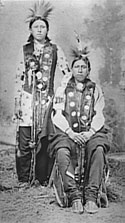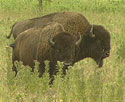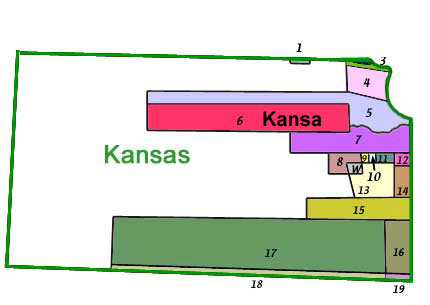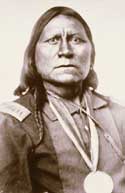
 |
Relations with Other Tribes
|
|
Horses Bring Greater Mobility
The presence of Euro-Americans had a
profound impact on the Kaws’ relations with other
Native American tribes. The Spanish brought horses to
the central plains and by the early 1700s the Kaws had
become accomplished equestrians. Horses afforded the Kaws and their Indian neighbors greater mobility over
longer distances which increased the frequency of both
peaceful trade but also raids and counter-raids between
the tribes.
|

|
|

copyright
|
Horses became enormously important as a means
for men to attain wealth and stature. Like all of the Indians
living in this area, the Kaw warriors took considerable pride in
being able to steal horses from their enemies.
|
Upon returning from
a successful raid, a Kaw warrior would be subject to much praise
if he were to have captured and herded home a dozen or more of the
enemies’ horses. Once the great Kaw warrior, Ne-ca-que-ba-na,
returned to the Kaw villages near Council Grove with a drove of
one hundred fifty horses he had captured from the Pawnees.
Ne-ca-que-ba-na distributed the horses to the three principal Kaw chiefs.
|
|
Fur Trade Promotes Competition |
|
Another European-induced factor which strained relations between
the Kaws and their Indian neighbors was competition in the fur
trade. From about 1700 on the Kaws had become dependent on
European and American-provided trade exchanged for animal pelts
delivered by the Indians.
|
 |
Competition was keen, sometimes
becoming violent, between the tribes vying for the best hunting
and trapping grounds. Often the white traders played tribes off
against each other and at times promoted intra-tribal
factionalism to gain a commercial advantage.
|
 |
The main enemy of the
Kaws were the
Pawnees, a large tribe living in present-day north-central
Kansas and central Nebraska. Throughout the 1700s the Kaws had
captured Pawnee people and sold them to the French as slaves.
|
| In
1812, the Pawnees attacked the Kaws’ Blue Earth Village.
Under the brilliant leadership of Burning Hart, the outnumbered Kaws
defeated the Pawnees, who lost eighty of their best
warriors and nearly all of their horses. The Kaws attacked the
Loup River Pawnees in late 1812 and lost thirty of their most
prized warriors. This reduction in warrior numbers made it hard
for the Kaw to compete for a fair share of the natural fur and
skin supply.
In addition to the Pawnees, Kaw adversaries included at
various times the Iowas, Sac and Fox, Otoes, Kiowas, Cheyennes, and even the
powerful Osages. After an American-arranged truce between the Osages and the Kaws
in 1806, the two tribes retained peaceful relations and Osage-Kaw
marriages became commonplace.
|
Emigrant Indians
Compete for Resources
In 1825 the Kaws gave
up considerable land in present-day Kansas and Missouri
for a smaller reservation. Much of the land vacated by
the Kaws was divided among other Indian nations that
had been forced to abandon their eastern homes. Among
these tribes were the Cherokee, Chippewa, Delaware,
Iowa, Iroquois, Kaskaskia, Kickapoo, Munsee, Ottawa,
Peoria, Piankashaw, Potawatomi,Quapaw, Sac and Fox,
Shawnee, Stockbridge, Wea, and Wyandot. These tribes,
often referred to as "emigrant Indians,"
competed with the Kaw in hunting and trapping the
dwindling bison herds and other fur-bearing animals.
|


|
Raids between other tribes and the Kaws continued almost to the time the
Kaws were removed from
Kansas. On June 3, 1868, seeking to avenge a defeat they had
suffered at the hands of the Kaws the previous winter, a large
contingent of Cheyenne warriors in full war regalia approached
Council Grove from the west. Part of them rode down Main Street,
terrifying a good many whites, some of whom barricaded
themselves in the Kaw Mission.
|

Santanta - Kiowa Chief
|
The Cheyennes engaged the Kaws about
three to four miles southeast of Council Grove. The Kaws dug
in along the creek banks and timber while the mounted Cheyennes
rode back and forth in open country, shouting and bluffing
charges while staying out of range of the Kaw rifles. Many
shots were fired during the four-hour skirmish, but only one Kaw
and one Cheyenne warrior were wounded. The Cheyennes
retreated late in the afternoon, looting a few area farmsteads
as they went.
|
|
|
|


